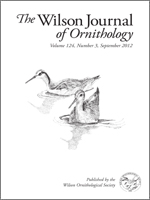I investigated the relationship between the probability of nest predation and nest-site characteristics: (1) nest height above ground, (2) number of branches attached to a nest, and (3) number of thorny branches around the nest for a population of Bull-headed Shrikes (Lanius bucephalus) breeding in Japan. Thirty-eight nests were located during 2008 and 2009 of which 16 were lost to predation, 14 were successful in fledging young, four were abandoned, two were parasitized, and two may have been partially depredated, although the actual reason is unclear. Neither nest height nor the number of thorny branches was correlated with breeding success. However, the number of branches was negatively correlated with probability of nest predation. The primary predators were believed to be birds, based on physical evidence at depredated nests. A high density of branches around nests of Bull-headed Shrikes may ensure they are not easily discovered and depredated by predators.
How to translate text using browser tools
1 September 2012
Nest-Site Characteristics Affect Probability of Nest Predation of Bull-Headed Shrikes
Sachiko Endo
ACCESS THE FULL ARTICLE





